Involvement of myeloid dendritic cells in the development of gastric secondary lymphoid follicles in Helicobacter pylori-infected neonatally thymectomized BALB/c mice
- PMID: 12654837
- PMCID: PMC152071
- DOI: 10.1128/IAI.71.4.2153-2162.2003
Involvement of myeloid dendritic cells in the development of gastric secondary lymphoid follicles in Helicobacter pylori-infected neonatally thymectomized BALB/c mice
Abstract
We previously described an animal model of Helicobacter pylori-induced follicular gastritis in neonatally thymectomized (nTx) mice. However, it is still not clear whether antigen-presenting dendritic cells (DCs) in the stomach have a role in the development of secondary follicles in H. pylori-infected nTx mice. We investigated the distribution of DC subsets using this model and examined their roles. To identify lymphoid and myeloid DCs, sections were stained with anti-CD11c (pan-DC marker) in combination with anti-CD8alpha (lymphoid DC marker) or anti-CD11b (myeloid DC marker) and were examined with a confocal microscope. Expression of macrophage inflammatory protein 3alpha (MIP-3alpha), which chemoattracts immature DCs, was analyzed by real-time PCR and immunohistochemistry. Follicular dendritic cells (FDCs) were stained with anti-SKY28 antibodies. In noninfected nTx mice, a few myeloid and lymphoid DCs were observed in the bottom portion of the lamina propria, whereas in H. pylori-infected nTx mice, there was an increased influx of myeloid DCs throughout the lamina propria. FDC staining was also observed in the stomachs of members of the infected group. MIP-3alpha gene expression was upregulated in the infected nTx group, and the immunohistochemistry analysis revealed MIP-3alpha-positive epithelial cells. These data suggest that H. pylori infection upregulates MIP-3alpha gene expression in gastric epithelial cells and induces an influx of myeloid DCs in the lamina propria of the gastric mucosa in nTx mice. Myeloid DCs and FDCs might contribute to the development of gastric secondary lymphoid follicles in H. pylori-infected nTx mice.
Figures
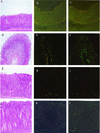
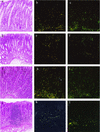

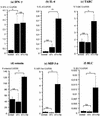
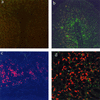
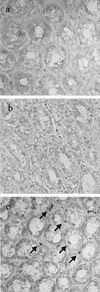
References
-
- De Togni, P., J. Goellner, N. H. Ruddle, P. R. Streeter, A. Fick, S. Mariathasan, S. C. Smith, R. Carlson, L. P. Shornick, J. Strauss-Schoenberger, et al. 1994. Abnormal development of peripheral lymphoid organs in mice deficient in lymphotoxin. Science 264:703-707. - PubMed
-
- Dieu-Nosjean, M. C., A. Vicari, S. Lebecque, and C. Caux. 1999. Regulation of dendritic cell trafficking: a process that involves the participation of selective chemokines. J. Leukoc. Biol. 66:252-262. - PubMed
-
- Dixon, M. F., R. M. Genta, J. H. Yardley, and P. Correa. 1996. Classification and grading of gastritis. The Updated Sydney Systematic International Workshop on the Histopathology of Gastritis, Houston 1994. Am. J. Surg. Pathol. 20:1161-1181. - PubMed
Publication types
MeSH terms
Substances
LinkOut - more resources
Full Text Sources
Other Literature Sources
Research Materials

